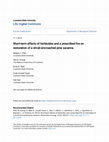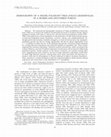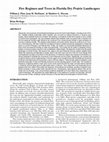Published Papers by Bill Platt
The authors of this paper comprise the Future of Fire Consortium.
Global change is altering interactions between ecological disturbances. We review interactions be... more Global change is altering interactions between ecological disturbances. We review interactions between tropical cyclones and fires that affect woody biomes in many islands and coastal areas. Cyclone-induced damage to trees can increase fuel loads on the ground and dryness in the understory, which increases the likelihood, intensity, and area of subsequent fires. In forest biomes, cyclone–fire interactions may initiate a grass–fire cycle and establish stable open-canopy biomes. In cyclone-prone regions, frequent cyclone-enhanced fires may generate and maintain
stable open-canopy biomes (e.g., savannas and woodlands). We discuss
how global change is transforming fire and cyclone regimes, extensively altering cyclone–fire interactions. These altered cyclone–fire interactions are shifting biomes away from historical states and causing loss of biodiversity.

Fire-plant feedbacks engineer recurrent fires in pyrophilic ecosystems like savannas. The mechani... more Fire-plant feedbacks engineer recurrent fires in pyrophilic ecosystems like savannas. The mechanisms sustaining these feedbacks may be related to plant adaptations that trigger rapid responses to fire's effects on soil. Plants adapted for high fire frequencies should quickly regrow, flower, and produce seeds that mature rapidly and disperse postfire. We hypothesized that the offspring of such plants would germinate and grow rapidly, responding to firegenerated changes in soil nutrients and biota. We conducted an experiment using longleaf pine savanna plants that were paired on the basis of differences in reproduction and survival under annual ("more" pyrophilic) versus less frequent ("less" pyrophilic) fire regimes. Seeds were planted in different soil inoculations from experimental fires of varying severity. The more pyrophilic species displayed high germination rates followed by species-specific rapid growth responses to soil location and fire severity effects on soils. In contrast, the less pyrophilic species had lower germination rates that were not responsive to soil treatments. This suggests that rapid germination and growth constitute adaptations to frequent fires and that plants respond differently to fire severity effects on soil abiotic factors and microbes. Furthermore, variable plant responses to postfire soils may influence plant community diversity and fire-fuel feedbacks in pyrophilic ecosystems.
Nature. This e-offprint is for personal use only and shall not be self-archived in electronic rep... more Nature. This e-offprint is for personal use only and shall not be self-archived in electronic repositories. If you wish to self-archive your article, please use the accepted manuscript version for posting on your own website. You may further deposit the accepted manuscript version in any repository, provided it is only made publicly available 12 months after official publication or later and provided acknowledgement is given to the original source of publication and a link is inserted to the published article on Springer's website. The link must be accompanied by the following text: "The final publication is available at link.springer.com".

Concepts regarding effects of recurrent natural disturbances and subsequent responses of communit... more Concepts regarding effects of recurrent natural disturbances and subsequent responses of communities are central to ecology and conservation biology. Tropical cyclones constitute major disturbances producing direct effects (damage, mortality) in many coastal communities worldwide. Subsequent reassembly involves changes in composition and abundance for which the underlying mechanisms (deterministic and stochastic processes) are still not clear, especially for mobile organisms. We examined tropical cyclone-induced changes in composition and reassembly of entire insect communities in 16 Louisiana coastal salt marshes before and after Hurricane Isaac in 2012 and 2013. We used the Shannon index and multivariate permutational ANOVA to study insect resistance and resilience, β diversity partitioning to evaluate the importance of species replacement, and null models to disentangle the relative roles of different assembly processes over time after the tropical cyclone. The α diversity and species composition, overall and for different trophic levels, decreased immediately after the tropical cyclone; nonetheless, both then increased rapidly and returned to pre-cyclone states within one year. Changes in species abundance, rather than species replacement, was the primary driver, accounting for most temporal dissimilarity among insect communities. Stochastic processes, which drove community composition immediately after the tropical cyclone, decreased in importance over time. Our study indicates that rapid reformation of insect communities involved sequential landscape-level dynamics. Cyclone-resistant life cycle stages apparently survived in some, perhaps random locations within the overall salt marsh landscape. Subsequently, stochastic patterns of immigration of mobile life cycle stages resulted in rapid reformation of local communities. Post-cyclone direct regeneration of salt marsh insect communities resulted from low resistance, coupled with high landscape-level resilience via re-immigration. Our study suggests that the extent of direct regeneration of local salt marsh insect communities might change with the size of larger marsh landscapes within which they are imbedded.

Globally, savanna trees experience bottlenecks to recruitment. Likelihoods are low that juveniles... more Globally, savanna trees experience bottlenecks to recruitment. Likelihoods are low that juveniles, especially of nonclonal, reseeder species, will survive and reach sizes that survive recurrent fires. We hypothesized if ground layer vegetation within savannas contained patches with reduced fire effects, likelihoods of juvenile trees surviving fires would be increased. We refined our general hypothesis based on a field study in an old-growth southeastern pine savanna of North America, in which longleaf pine (Pinus palustris Mill.) is the most abundant tree. We hypothesized that recruitment of pines into the fire-resistant 'grass stage' may be more likely in three ground layer microhabitats (inside crowns of fallen pines, around pine tree stumps, and inside patches of oak/hardwood stems) than in surrounding groundcover located away from overstory pines. We measured the composition and abundance of ground layer vegetation and censused juvenile grass stages (, 1.5 m height) of longleaf pine in plots in replicated patches of these three microhabitats and in the surrounding ground layer matrix, all located away from large trees. Ground layer vegetation was less abundant inside than outside the three microhabitats and abundances of grasses and shrubs differed among microhabitats. A zero-inflated Poisson model indicated that occurrence of grass stage longleaf pines was .5 times more likely inside the three microhabitats than in the surrounding ground layer matrix. Recruitment was also more likely in pine than oak/hardwood microhabitats. We propose that altered microhabitats, especially those generated by death of large longleaf pines, likely facilitate recruitment into populations of this reseeding savanna tree.
Water Limitation, Fire, and Savanna Persistence, 2019
Savannas are terrestrial biomes typically characterized by the coexistence of grasses and woody p... more Savannas are terrestrial biomes typically characterized by the coexistence of grasses and woody plants (Chapter 1). Two broad physiognomies can be distinguished in savannas on the basis of the presence or absence of a woody overstory. The savanna physiognomy (hereafter savanna) is broadly characterized by a continuous herbaceous ground layer, which we collectively refer to as "grass, " and an incomplete overstory of woody plants (
Natural Areas Journal, 2004
ABSTRACT: Fire regimes of pine savannas on barrier islands along the coast oí lhe Gulf of Mexico ... more ABSTRACT: Fire regimes of pine savannas on barrier islands along the coast oí lhe Gulf of Mexico are unknown. We used dendrochronological techniques lo precisely date scars from 52 slash pines {Pinus eilioftii Engelm.) located within a 370 ha area on Linie St George Island. Florida, USA, an undeveloped barrier island. We determined the ytans and seasons of fires and turpentine operations, and mapped the Spatial distribution of past fires. We identified five separate periods with different fire frequencies. Fires were frequent between ...
Ecological Monographs, 2016

Restoration Ecology, 2015
Shrub encroachment occurring worldwide in savannas and grasslands has commonly been hypothesized ... more Shrub encroachment occurring worldwide in savannas and grasslands has commonly been hypothesized to result from anthropogenically altered environments. Two disturbance-based approaches to restoration have involved: (1) application of selective herbicides to reduce density/cover of shrubs; (2) reinstatement of natural fire regimes to generate environmental conditions favoring herbaceous species. We studied short-term responses of native shrubs, vines, and grasses in a Louisiana pine savanna to herbicides followed by a prescribed fire and fire alone. Plots established in the summer, 2013, were hand-sprayed in the fall with Imazapyr and Triclopyr, Triclopyr alone, or no herbicide, then prescribed burned the following spring. Numbers of species of shrubs and vines at scales of 1 and 100 m 2 , numbers of stems and regrowth of stems produced by six common species of shrubs, and the number of flowering culms of perennial C 4 grasses were assessed postfire in 2014. Compared with fire alone, herbicides followed by fire resulted in (1) small reductions in species richness of shrubs and no effects on vines, (2) fewer stems comprising shrub genets, but similar postfire regrowth of resprouting shrub stems, and (3) fewer flowering culms of C 4 grasses. Underground storage organs of savanna shrubs and vines survived both aboveground disturbances. Thus, single applications of herbicides followed by fires reduced, but did not reverse shrub encroachment and negatively affected grasses. Because effects of herbicides overrode those of prescribed fires, these disturbances did not act synergistically, suggesting that reinstating natural fire regimes should be a priority in restoration of savannas and grasslands.

We assessed the responses of tree populations in an old-growth Southern mixedhardwood forest in n... more We assessed the responses of tree populations in an old-growth Southern mixedhardwood forest in northern Florida to hurricane disturbance. The most recent, Hurricane Kate (1985), damaged 41% and killed 7% of the overstorey trees, eliminated 8% of the basal area, and increased the area in canopy gaps from 31% to 62%. 2 We focused on changes in recruitment, growth and mortality of trees of the 10 most abundant tree species (> 93% of the basal area). We analysed data from 7149 trees ≥ 2 cm d.b.h., recorded in periodic censuses of a 4.5-ha plot over the period spanning 7 years before and 7 years after the disturbance. 3 After Hurricane Kate, recruitment into the ≥ 2 cm d.b.h. class increased sixfold, and rates of growth and survival increased for saplings and understorey trees, but decreased for overstorey trees. 4 We classified the tree populations into four previously defined syndromes of response to disturbance according to observed mortality, recruitment and growth patterns. Pinus glabra exhibited the Resilient syndrome, with high tree mortality but massive recruitment after the hurricane. Two subcanopy species (Carpinus caroliniana and Ostrya virginiana) and three canopy species (Liquidambar styraciflua , Quercus michauxii and Q. nigra), exhibited the Usurper syndrome, showing low tree damage, some release of understorey trees and saplings, and substantial recruitment. Ilex opaca (subcanopy), and Fagus grandifolia and Nyssa sylvatica (canopy), exhibited the Resistant syndrome, characterized by low tree damage and little increase in recruitment. The main canopy dominant, Magnolia grandifolia , exhibited the Susceptible syndrome; it had large reductions in growth and survival and no detectable release of understorey individuals. 5 Short-term persistence was not compromised by Hurricane Kate in any of the 10 tree populations because the majority of trees were resistant to hurricane damage. The long-term persistence of populations exhibiting the Resistant syndrome appeared to be independent of hurricane disturbance. Long-term persistence appeared to depend on periodic hurricanes (or equivalent large-scale disturbances) for Resilient and Usurper syndromes, but might become compromised by recurrent hurricanes for the Susceptible syndrome.
The American Naturalist, 1988
The American Naturalist, 2009

PloS one, 2012
Ecological disturbances frequently control the occurrence and patterning of dominant plants in hi... more Ecological disturbances frequently control the occurrence and patterning of dominant plants in high-diversity communities like C(4) grasslands and savannas. In such ecosystems disturbance-related processes can have important implications for species, and for whole communities when those species are dominant, yet mechanistic understanding of such processes remains fragmentary. Multiple bunchgrass species commonly co-dominate disturbance-dependent and species-rich pine savannas, where small-scale fuel heterogeneity may influence bunchgrass survival and growth following fires. We quantified how fire in locally varying fuel loads influenced dynamics of dominant C(4) bunchgrasses in a species-rich pine savanna in southeastern Louisiana, USA. We focused on two congeneric, co-dominant species (Schizachyrium scoparium and S. tenerum) with similar growth forms, functional traits and reproductive strategies to highlight effects of fuel heterogeneity during fires. In experimental plots with ei...

Ecology, 1998
We examined the demographic responses of Fagus grandifolia to Hurricane Kate (1985) in an old-gro... more We examined the demographic responses of Fagus grandifolia to Hurricane Kate (1985) in an old-growth Southern mixed-hardwood forest in northern Florida. Matrix population models were used to contrast pre-and post-hurricane population trends (1978-1992) with predictions of four hypotheses of the persistence of this shade-tolerant species in hurricane-frequented forests (resistance, recovery, release, and complementation). Although growth and mortality schedules changed as a result of the hurricane, the asymptotic population growth rate did not change significantly and did not depart significantly from ϭ 1 (stability) in either the pre-or the posthurricane periods. Long-term trends simulated for varying hurricane frequencies also projected stability in population size. These results supported the resistance hypothesis. Elasticity analysis showed that, while recruitment had a minor influence, survival of medium-sized trees was the most critical character influencing population growth. Similar patterns of life history sensitivity are common among other trees, suggesting that traits related to survival of large understory individuals would often be under high selection pressure. Among these traits, those associated with hurricane resistance could also be advantageous in forests subjected to light to moderate disturbance. Thus, resistance to canopy disruption could have remained linked to shade tolerance during expansions and contractions of the distribution of F. grandifolia.

Ecology, 2002
Differences in initial large-scale disturbances might change effects of subsequent large-scale di... more Differences in initial large-scale disturbances might change effects of subsequent large-scale disturbances. We explored possible effects of prior fire regimes on subsequent hurricane-related mortality of south Florida slash pine (Pinus elliottii var. densa) in remnant Everglades pine savannas that were unburned, burned during the wet (lightning fire) season, or burned during the dry (anthropogenic fire) season in the decade before Hurricane Andrew (1992). We measured direct mortality during Andrew (snapped trees) and extended mortality over the subsequent 24-30 mo (mainly insect attacks on damaged trees). We used Bayesian model averaging to obtain probabilities of different models of survival based on fire regime and site characteristics (remnant area, distance to the Atlantic Ocean, depth to water table in the dry season, sustained wind speeds, tree sizes). Most likely models for direct and extended mortality included large negative effects of tree size and dry-season fire regime, and positive effects of stand area (direct mortality) and wetseason fire regime (extended mortality). Depth to water table and distance to the ocean had less certain effects. Our results, not predicted from fires or hurricanes alone, suggest that anthropogenic changes to dry-season fires strongly influence the effects of subsequent hurricanes on the mortality of pines in subtropical savannas.

Land fire and water: the …, 2006
Historically, pine savannas characterized landscapes across the Gulf Coastal Region, including mo... more Historically, pine savannas characterized landscapes across the Gulf Coastal Region, including most of Florida. Treeless habitats (historically called "prairies") also occurred as lowland inclusions in savanna landscapes. What restricted trees from prairies? We develop a conceptual model that is based on prior models of prairie-forest landscapes. We use predicted relationships between trees and graminoids to explore how fire and seasonal flooding might influence the continuum from closed-canopy forests to open-canopied savannas to treeless prairies. The starting model predicts community position along this continuum as a function of fire frequency. We then modify this conceptual model to include evolutionary adaptations of trees that result in survival of frequent, low-intensity fires. Finally, we modify it to incorporate postulated interactive effects of fire and seasonal flooding on trees and graminoids. This model may be useful in predicting characteristics of savanna-prairie mosaics in the southeastern United States. We apply this model to the dry prairie landscape of central Florida. We examine two regions with pine flatwoods and dry prairies: Myakka River State Park (Sarasota and Manatee Counties) close to the Gulf coast and Avon Park Air Force Range (Polk and Highlands Counties) in the interior of the peninsula. For these two regions we compare local climatic conditions predicted to facilitate the occurrence of pine flatwoods and dry prairie. Specifically, we compare the conditions likely to result in lightning fires in the two regions and compare those with the likelihood of post-fire flooding in pine flatwoods and dry prairies in each of the two regions. These climatic patterns indicate a close temporal association of fires and flooding during the summer growing season at both sites. The increase in frequency of lightning strikes in April-June occurs at the same time that the mean rain-free interval reaches a maximum and the mean ground water levels reach a minimum. Thus, large fires in the landscape are expected at this time. Within a few weeks the frequency of thunderstorms increases, resulting in frequent rains. Rapid increases in mean water levels saturate the soil. Consequently, early lightning season fires are followed soon by flooding. Thus, environmental conditions predicted not to favor trees occur seasonally in dry prairie landscapes. We anticipate that subtle differences in the likelihood of surface soil saturation will influence survival of trees, resulting in prairie inclusions in the pine flatwoods landscapes of central Florida.










Uploads
Published Papers by Bill Platt
stable open-canopy biomes (e.g., savannas and woodlands). We discuss
how global change is transforming fire and cyclone regimes, extensively altering cyclone–fire interactions. These altered cyclone–fire interactions are shifting biomes away from historical states and causing loss of biodiversity.
stable open-canopy biomes (e.g., savannas and woodlands). We discuss
how global change is transforming fire and cyclone regimes, extensively altering cyclone–fire interactions. These altered cyclone–fire interactions are shifting biomes away from historical states and causing loss of biodiversity.